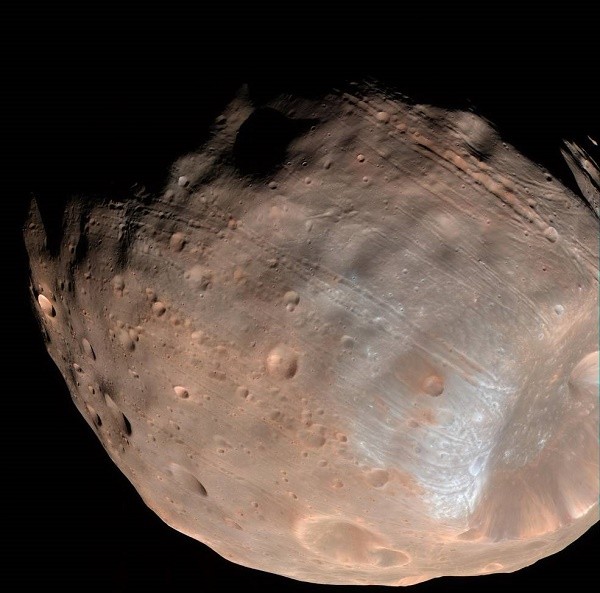Astronomers reveal how Mars is slowly destroying one of its two moons, piece by piece as scientists believe that Phobos may eventually disintegrate and completely disappear into space. However, this process may take 30 to 50 million years from now.
New findings reveal how parallel grooves on the surface of the Martian moon Phobos, were apparently structures that are telltale signs of a cosmic collision that occurred a long time ago with another primordial space object. Now, these are believed to be early signs of a failing structure that can lead to an ultimate destruction as cracks are slowly widening and opening up.
Scientists are now suggesting that this massive impact almost completely shattered Phobos where it only left an accumulation of rubble and space rocks that are bonded together by a thin, fragile surface crust which means that the moon is just a huge orbiting mass of rocks.
The gravitational forces of Mars are probably weakening the outer layer of Phobos where Phobos is the closest moon to its host planet than any other moon to theirs in the entire solar system. The distance of Phobos from the surface of Mars is only a mere 3,700 miles.
According to Terry Hurford from NASA's Goddard Space Flight Center, we believe that Phobos has started to fail where the first sign of this failure is manifested by the production of these grooves.
Scientists likened to the grooves that appeared on the surface of Phobos as "stretch marks", which are considered as strong evidence on the outer surface of the moon, measuring no more than 100 meters thick as Martian gravity is producing tidal forces that are now slowly deforming the moon.
According to Erik Asphaug from the School of Earth and Space Exploration in Arizona State University, the surprising thing about this result from the tidal forces is that Phobos apparently has a mildly cohesive outer layer of fabric.
Researchers explain this outer layer as behaving with elastic properties and readjusting to distortions found inside the moon's interior that are all caused by Martian gravity however, this layer is thin and weak and if it becomes stressed out too much, the structure will ultimately fail.
New models based on these stresses can create hypothetical scenario structures that are also observed on the surface of the moon, researchers say.
Phobos is also tiny, measuring just 13.5 miles in diameter as Mars pulls the moon closer to it at 6.6 meters every 100 years. Researchers also add that this event is not unique as another moon of Neptune awaits a similar fate, where Triton is orbiting closer to Neptune that can also lead to fractures and structure failure.



























